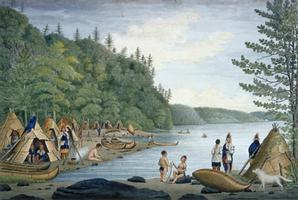Topographic Painters
Topographic studies grew out of 16th-century Europe's interest in specific views of places and their details. Precision was important, either for reasons of pride and record taking, for strategic purposes, or for evocation of poetic views which opened new vistas to the viewer's imagination. In Canada topographic views in paintings can be seen in some rare examples of church paintings and portraits from as early as late 17th-century New France, or from the recent 20th century, when portions of the St Lawrence River were recorded before they became the Seaway. However, the richest period was the late 18th and 19th centuries, a period when the art of draftsmanship and painting in watercolour flourished, particularly in Great Britain, and was pursued by professionals and amateurs alike. Among the British soldiers and civilians stationed in Canada during this period, many were topographic painters who left a rich heritage of early views of the country and its people.
Topography was a subject taught at the Woolwich Royal Military Academy by artists such as Paul Sandby, who achieved his fame with ornamental landscapes that combined the precision of topography with a flexible and poetic visual technique.
Among those influenced by such teachers were soldier-topographers such as Hervey Smyth, who depicted the size of the English military force which captured France's strongholds; Richard Short, whose drawings of Québec City after the siege show the strength of the British fleet as well as the architectural richness of the town and its good-natured inhabitants; Thomas DAVIES, who preferred watercolours which show scenes in which man and nature live in harmony; George HERIOT, whose illustrated Travels Through the Canadas enjoyed a large readership in Europe and North America; and James Pattison COCKBURN, who produced a large collection of watercolours of Québec City and its environs.
Topographic artists portrayed an idealized and often spectacular landscape. MONTMORENCY FALLS was a favourite subject with many of them. As others of their age, Davies and Heriot believed that all of nature could be drawn for man's pleasure like a large parkland in the British style, far removed from the more serious concerns of living; in their landscapes, habitants and American Indians tended to be exotic and picturesque, and colonial administrators genteel and well dressed. There were also less idealistic views, as for example those of John Webber, a crew member on the ship of James Cook when he explored the Pacific Ocean. Since such paintings or drawings were sometimes produced as engravings in Europe or the US, topographical painters helped to spread interest elsewhere in British North America.
The techniques and approaches continued to be used by others, by explorers such as George BACK, adventurers such as William HIND, wives of administrators, such as Lady Dufferin and Elizabeth SIMCOE, wives of churchmen, such as Henrietta Cartwright, or engineers such as William ARMSTRONG. Topographic painters helped, through their records, to enliven aspects of Canadian history not visually accessible otherwise, and also allowed some scope for the imagination.

 Share on Facebook
Share on Facebook Share on X
Share on X Share by Email
Share by Email Share on Google Classroom
Share on Google Classroom







